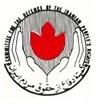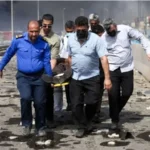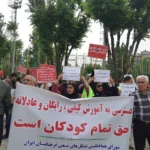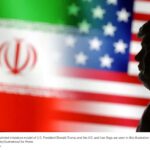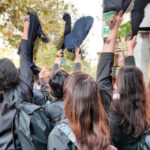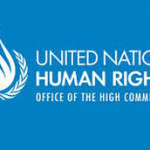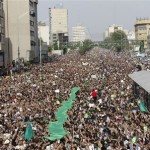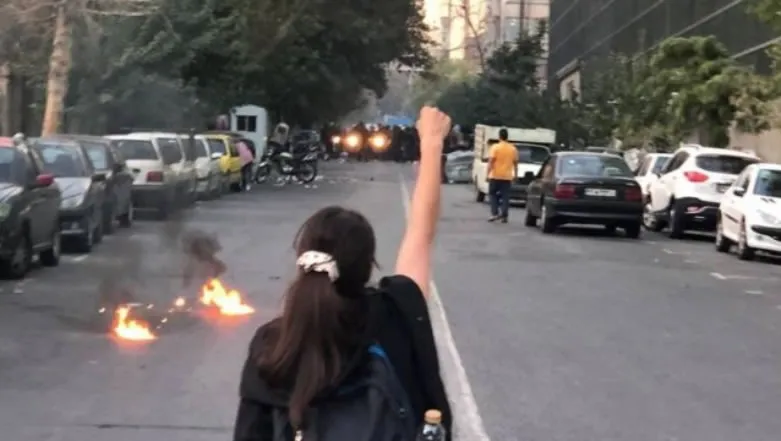
This year, as progressives around the world prepared to mark International Women’s Day, the women of Iran did so on the back of a courageous and inspiring six-month long struggle – one in which they have led from the front – against the country’s ruling theocratic dictatorship.
The massive popular uprising in Iran that began in September 2022 has featured the country’s women at the very forefront. While the protests first centered on the killing of 22-year-old Mahsa Amini at the hands of the so-called “Guidance Patrol” or “Morality Police” and the enforcement of mandatory hijab, they quickly escalated to calls for an end to the entire authoritarian system of theocratic rule.
The regime’s response to the popular protests is sheer brutality; nearly 600 people, (including more than 70 innocent children) have been killed by the regime’s thugs, at least 4 protesters have been executed, and nearly 20,000 people have been arrested and subjected to torture.
Countless women have been blinded, injured, and maimed by the regime's enforcers, while their calls for freedom have been perversely taken as a green light by these same thugs to sexually abuse, rape, and torture them upon their arrest. The disappearance of protesters has become commonplace. The battered and mutilated bodies of many women are found after days of disappearance, and the families of those killed are then attacked during funerals or mourning ceremonies.
The general antipathy towards the regime and broad inclusiveness of the "Woman, Life, Freedom" slogan allowed for the encompassing of a wide swathe of Iranian society in the protest movement - which also represented a direct continuation of previous recent popular uprisings in the country.
A central thread running throughout these uprisings has been the catastrophic and ever worsening economic crisis in Iran, which is primarily the end-result of the regime's implementation of neoliberal economic policies from the early-1990s onwards. As a result, according to official government statistics, more than 40% of the country's population lives below the poverty line - though the situation is believed to be much worse in reality. This crisis is compounded by endemic corruption and cronyism, all overseen by a fiercely repressive dictatorship which can be legitimately characterised asmisogynistic to its very core.
The intensification of gender discrimination, along with class discrimination, is the result of the dominance of "Political Islam" and its regressive norms. According to the latest official statistics, 60% of educated women are unemployed while 70% of Iranian women do not have stable jobs or income. In the spring of 2022, the economic participation rate of women was reported as 13.7%, which is less than one fifth of the rate of their male counterparts (69.1%).
The Islamic Republic's constitution has essentially entrenched and normalised discrimination against women across society - not least in the fields of education and employment, thereby hindering any real opportunity to attain economic independence. This is compounded by the imposition of the mandatory hijab; the issuing of edicts obliging marriage and the bearing of more children, all weighed in favour of the male party to the relationship; as well as the passing of regressive laws, the application of which subordinate women and make them even more vulnerable to the all too commonplace abuse, harassment, and threatening of women in the public sphere.
In this uprising, women have once more demonstrated their key and prominent historical role in advancing the cause of social justice in Iran. The movement under "Woman, Life, Freedom" has quickly galvanised support beyond Iran's borders and has even been referred to as a "women's revolution" in some quarters.
However, the reality remains that the Islamic Republic regime will seek to maintain its brutal rule whatever the cost to the people of Iran - and the country's women will bear the brunt for as long as that remains so.
This is undoubtedly a perilous time for the progressive currents, including the women's movement, in Iran. Imperialism and the western powers have deployed their propaganda machine and wider resources in an attempt to commandeer the nascent popular movement and control the narrative of developments particularly outside Iran and in the diaspora.
However, the people of Iran have learnt from the painful experience of the defeat of the February 1979 Revolution that replacing one autocratic regime with another can never satisfy the enduring demands of the overwhelming majority for freedom, independence, and social justice.
The people of Iran remain resolutely opposed to any outside interference - whether from imperialism or reactionary regimes in the Middle East region - in the internal affairs and course of political developments of the country. Such matters are the sole remit of the Iranian people themselves.
What is needed for the ultimate success of the movement is a coalition of political forces that can gain the support of the working people and popular strata with a joint action plan to meet the urgent demands of the majority of the Iranian people.
A major encouraging development, in this direction, is the recent issuing of a 12-point charter by a coalition of independent trade union and civil organisations inside Iran -warmly welcomed by progressive currents inside Iran and publicly endorsed by former prime minister and leader of the opposition Green Movement, Mir-Hossein Mousavi, amongst others.
The charter includes provisions such as the immediate and unconditional release of political prisoners; the public trials of the perpetrators of suppression of the popular protests; freedom of opinion, expression (including the media), assembly, and industrial action; and immediate abolition of the death penalty as well as any type of torture. The recognition of women’s rights as equal to those of men has also been emphasised in the charter.
The Democratic Organisation of Iranian Women (DOIW) resounds its urgent call for the support and solidarity of democratic, progressive, and pro-peace forces around the world for the popular anti-dictatorship movement inside Iran – and, to this end, for the just and proper utilisation of already-existing international structures and mechanisms via the United Nations Human Rights Council, World Peace Council, International Labour Organisation, and international trade union confederations.
After months of upheaval, the resolve and will of the long-suffering Iranian people is manifest… And, it is no exaggeration to state the country stands on the cusp of radical change.
___________________________________________________________________________
This article is based on a presentation of Dr. Azar Sepehr to a successful IWD event in London on 11th March that CODIR was involved in organising. Ms Sepehr is the spokesperson for the Democratic Organisation of Iranian Women (DOIW) (Tashkilat-e Demokratik-e Zanan-e Iran), Iran’s largest and longest-established progressive women’s organisation, which was founded on 18 February 1943, by a group of left women activists.
For more information, visit their website at https://www.tdzi.org/en/home/

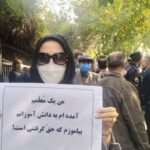
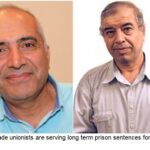
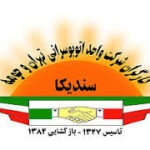

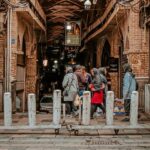
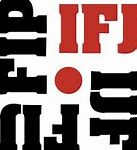


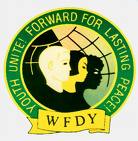
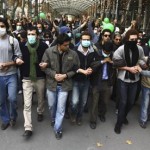
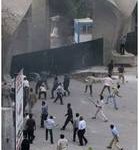
 Posted in
Posted in 